Digital Technology Agenda for Business in 2016
Technology innovation is accelerating faster than companies can keep up with. Many feel pressure to adopt new strategies that technology makes possible and find the resources required for necessary investments. In 2015 our research and analysis revealed many organizations upgrading key business applications to operate in the cloud and some enabling access to information for employees through mobile devices. Despite these steps, we find significant levels of digital disruption impacting every line of business. In our series of research agendas for 2016 we outline the areas of technology that organizations need to understand if they hope to optimize their business processes and empower their employees to handle tasks and make decisions effectively. Every industry, line of business and IT department will need to be aware of how new technology can provide opportunities to get ahead of, or at least keep up with, their competitors and focus on achieving the most effective outcomes.
Let’s review the digital disruptions that are impacting businesses of every size in any industry.
Analytics is at the top of the list. It has become indispensable not just for measuring performance and efficiency but also for guiding effective actions that make critical differences in an organization. Once just an ad hoc part of business intelligence efforts, analytics now can have a continuous role in 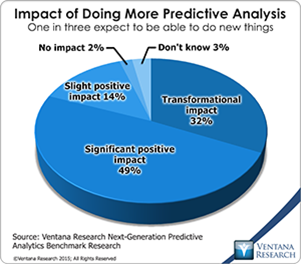 streamlining business processes. Historical analysis – measuring the past to inform the present – is no longer sufficient; looking forward with predictive analytics can help organizations anticipate future behavior and outcomes. Our benchmark research on predictive analytics shows that nearly half (49%) of organizations expect to gain significant impact from utilizing it, and another one-third (32%) said it can have transformational impact.
streamlining business processes. Historical analysis – measuring the past to inform the present – is no longer sufficient; looking forward with predictive analytics can help organizations anticipate future behavior and outcomes. Our benchmark research on predictive analytics shows that nearly half (49%) of organizations expect to gain significant impact from utilizing it, and another one-third (32%) said it can have transformational impact.
However, to develop continuous analytics organizations first must prepare for use the data to be analyzed. Typically this requires significant amounts of time from analysts, data and 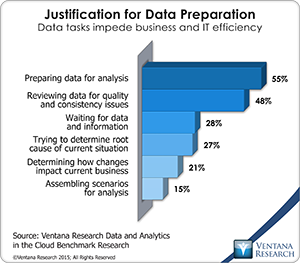 operations professionals – time that could be used more productively. Today they can regain that time by using data preparation tools designed for this purpose. In 2016 we will perform in-depth market research on data preparation to assess the variety of ways in which it is used and where it can offer the greatest benefit to analytics and operations. Our research in 2015 found that preparing data for analysis is the most common impediment in the analytics process for more than half (55%) of organizations, as it has been for the past five years. We also will conduct and publish new research on the role of analytics in the sales, finance and human resources functions. In these and other lines of business we assert that organizations must develop competencies in analytics and begin using them continuously to improve their performance and competitiveness. Look at your own organization to determine if you have made analytics a priority and is being used effectively.
operations professionals – time that could be used more productively. Today they can regain that time by using data preparation tools designed for this purpose. In 2016 we will perform in-depth market research on data preparation to assess the variety of ways in which it is used and where it can offer the greatest benefit to analytics and operations. Our research in 2015 found that preparing data for analysis is the most common impediment in the analytics process for more than half (55%) of organizations, as it has been for the past five years. We also will conduct and publish new research on the role of analytics in the sales, finance and human resources functions. In these and other lines of business we assert that organizations must develop competencies in analytics and begin using them continuously to improve their performance and competitiveness. Look at your own organization to determine if you have made analytics a priority and is being used effectively.
Another precursor to continuous analytics is collecting and processing what is commonly called big data, the huge volumes and broad variety of data that organizations encounter. Advances in computing technology including in-memory processing and storage of big data are now cost-effective and can be readily accessed and used through cloud computing. Because not all data is the same, ranging from structured data to unstructured content, documents and text, how businesses 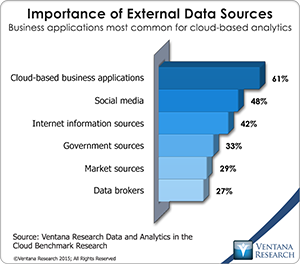 manage their information assets is just as important as the guidance they receive from analyzing them. To further investigate the impact of big data on business, we will perform new benchmark research to determine where investment can have the greatest impact in terms of value and time savings. Managing data effectively enables organizations to optimize their information, and there are other sources of data that can add to what they know. My colleague Robert Kugel has named this “cryptic data”; typically it is out of reach of business users, tucked away on the Internet and in external sources, but accessing it could enrich the value of existing information and analytics. Last year our data and analytics in the cloud benchmark research found that Internet information sources are important to 42 percent of organizations.
manage their information assets is just as important as the guidance they receive from analyzing them. To further investigate the impact of big data on business, we will perform new benchmark research to determine where investment can have the greatest impact in terms of value and time savings. Managing data effectively enables organizations to optimize their information, and there are other sources of data that can add to what they know. My colleague Robert Kugel has named this “cryptic data”; typically it is out of reach of business users, tucked away on the Internet and in external sources, but accessing it could enrich the value of existing information and analytics. Last year our data and analytics in the cloud benchmark research found that Internet information sources are important to 42 percent of organizations.
It is important to remember that big data is not just about data management but also about how it is interconnected and used for business purposes. Industry jargon that isolates it in “data lakes” and other ridiculous terms do a disservice to its full potential for analytics and any range of applications, extending even to advances in the Internet of Things (IoT), which connects whole networks and myriad devices to each other. Beyond this data science has intersected with expert systems to produce cognitive computing systems that can learn from past and present decisions and interactions to answer questions in natural language and guide decisions to optimal results.
In the excitement over big data and analytics it’s easy to forget that they are useful only when people work with them, and businesses rely on their people to interact and collaborate to reach agreement or better understand opportunities and situations to be resolved. Through a new generation of digital technologies, workers and managers alike can engage in discussions interactively online, through videoconferences that can share applications and presentations and with mobile technologies that make it simpler to collaborate at any time from any place. Our next-generation learning management benchmark research found that social collaboration is critical for more than half of organizations to share learning socially through activity streams. Technology enables even digital “town hall” meetings in which workers anywhere on the planet join in interactive  discussions. But collaborative technologies must be used in context of business processes that rely on business applications in which information must be shared, assessed and acted upon to achieve specific goals. Thus the idea of embedding collaboration in business application is taking hold among large application providers, although some just make it available separately. Our research in the past several years has identified collaboration as one of the most widely recognized digital technologies to advance business processes; for example, more than one-third (38%) of participants in our data and analytics in the cloud research are using it, although fewer than that (30%) are satisfied with how they collaborate, which is not surprising when many are still using email as the primary mode of collaboration. The good news is that new methods are gaining traction: Almost half (47%) are planning to use or are evaluating discussion forums, and nearly as many (48%) are interested in wall posting. New research we’ll produce in 2016 will identify the further adoption of collaboration and best practices in contact centers, sales, human resources and finance groups. Furthermore, to better engage workers in the organization, a new generation of digital feedback techniques used in consumer applications for easy-to-rate feedback is migrating into business. In general collaboration using digital techniques is still one of the most underutilized methods in organizations, but it can have large returns on investment since it engages and should motivate workforces to interact with others and management.
discussions. But collaborative technologies must be used in context of business processes that rely on business applications in which information must be shared, assessed and acted upon to achieve specific goals. Thus the idea of embedding collaboration in business application is taking hold among large application providers, although some just make it available separately. Our research in the past several years has identified collaboration as one of the most widely recognized digital technologies to advance business processes; for example, more than one-third (38%) of participants in our data and analytics in the cloud research are using it, although fewer than that (30%) are satisfied with how they collaborate, which is not surprising when many are still using email as the primary mode of collaboration. The good news is that new methods are gaining traction: Almost half (47%) are planning to use or are evaluating discussion forums, and nearly as many (48%) are interested in wall posting. New research we’ll produce in 2016 will identify the further adoption of collaboration and best practices in contact centers, sales, human resources and finance groups. Furthermore, to better engage workers in the organization, a new generation of digital feedback techniques used in consumer applications for easy-to-rate feedback is migrating into business. In general collaboration using digital techniques is still one of the most underutilized methods in organizations, but it can have large returns on investment since it engages and should motivate workforces to interact with others and management.
Another major new digital technology that has reshaped the way organizations use information is cloud computing, which enables applications or services to operate beyond an enterprise’s own premises. It can help organizations simplify access to and use of software by removing barriers of resources and 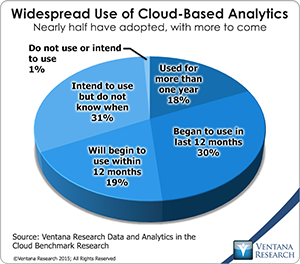 skills, allowing any size of organization to exceed its previous computing capabilities. Simplifying the ability to onboard a range of software whether business applications or other tools and to manage them easily in any area of business in conjunction with IT policies provides a radically faster time to value. We have also seen this in the use of analytics, as almost half of organizations in our data and analytics in the cloud research already use cloud-based analytics in some manner and another one-fifth (19%) will use it in the next year. Now organizations are shifting to integrating business applications in the cloud and in the enterprise, a process that requires integration software designed to help streamline interoperability. Underlying this transition of business computing is a movement toward the platform as a service (PaaS) and messaging that interconnects business and consumers in a range of cloud environments – public, private and hybrid. The enterprise architecture of the future is centered in the cloud; much of the software industry has shifted to this approach, and business organizations will be required to adapt or be left using and managing their own software. It is only a matter of time until they will not have a choice as new applications are rapidly becoming available only in the cloud.
skills, allowing any size of organization to exceed its previous computing capabilities. Simplifying the ability to onboard a range of software whether business applications or other tools and to manage them easily in any area of business in conjunction with IT policies provides a radically faster time to value. We have also seen this in the use of analytics, as almost half of organizations in our data and analytics in the cloud research already use cloud-based analytics in some manner and another one-fifth (19%) will use it in the next year. Now organizations are shifting to integrating business applications in the cloud and in the enterprise, a process that requires integration software designed to help streamline interoperability. Underlying this transition of business computing is a movement toward the platform as a service (PaaS) and messaging that interconnects business and consumers in a range of cloud environments – public, private and hybrid. The enterprise architecture of the future is centered in the cloud; much of the software industry has shifted to this approach, and business organizations will be required to adapt or be left using and managing their own software. It is only a matter of time until they will not have a choice as new applications are rapidly becoming available only in the cloud.
Until recently many businesses have worried about the security of systems they don’t deploy and control themselves. Our data and analytics in the cloud benchmark research  shows that lack of confidence in security is still the most frequent impediment to deployment cloud-based analytics, in more than half (56%) of organizations. Arising from these worries is new digital technology designed to ensure cybersecurity and protect intellectual assets (systems, internal data and customer information) from being hacked and compromised. More than a few large-scale incidents have shown that such attacks can significantly impact not only financial profitability but an organization’s credibility. Alert organizations now realize that just protecting the network that connects their computers and systems is insufficient to ensure that the full range of threats is mitigated. For example, most organizations have not effectively inventoried and assessed their IT assets to identify outdated software that might have known cyber exposures that can create wormholes that work from inside the organization to the outside. Building on IT asset management is the ability to identify legacy systems that increase threats and put data at risk in databases or from systems and tools that access them from more than one location. Such vigilance requires a sophisticated set of technology that not only detects and responds to threats but can recommend and even act on cyber exposures before situations reach crisis levels. The data within databases and analytics also needs to be secured. This challenge will require a new generation of cyberintelligence that is managed directly by the CIO’s office and understood by business management.
shows that lack of confidence in security is still the most frequent impediment to deployment cloud-based analytics, in more than half (56%) of organizations. Arising from these worries is new digital technology designed to ensure cybersecurity and protect intellectual assets (systems, internal data and customer information) from being hacked and compromised. More than a few large-scale incidents have shown that such attacks can significantly impact not only financial profitability but an organization’s credibility. Alert organizations now realize that just protecting the network that connects their computers and systems is insufficient to ensure that the full range of threats is mitigated. For example, most organizations have not effectively inventoried and assessed their IT assets to identify outdated software that might have known cyber exposures that can create wormholes that work from inside the organization to the outside. Building on IT asset management is the ability to identify legacy systems that increase threats and put data at risk in databases or from systems and tools that access them from more than one location. Such vigilance requires a sophisticated set of technology that not only detects and responds to threats but can recommend and even act on cyber exposures before situations reach crisis levels. The data within databases and analytics also needs to be secured. This challenge will require a new generation of cyberintelligence that is managed directly by the CIO’s office and understood by business management.
As if all this was not complicated enough, now we have the Internet of Things (IoT) emerging. Devices, machines and networks that are interconnected to the Internet through sensors and messaging are no longer just for monitoring but also for interactive dialogues that notify and take action on threats or malfunctions. As we evolve to this technologically sophisticated world, even things we wear, from watches to certain types of clothing, also can provide information on business and personal activities that range from responding to requests to the wellness of individuals. The underlying connectivity comes from the use of Bluetooth and RFID for cellular or WiFi connections directly onto the Internet. As we find ways to miniaturize and embed sensors and related technology that can provide data, we also find that the processing is operating at the edge of the network and within machines, even automobiles. These Internet-level bots do not just operate at the edge of the network but can also transport themselves to where processing needs to happen. IoT will require applications that can monitor systems and also be used to manage monetization as in subscription to services and interact across any range of services. Such a change will require advanced skills in IoT analytics and capabilities for real-time processing; we call this the next generation of operational intelligence and are conducting new market research to determine the rate of innovation and emerging best practices in adoption of the technologies.
As we all can see, smartphones and tablets are 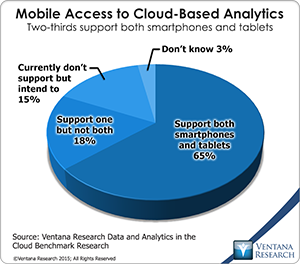 everywhere, connecting people and the Internet. The potential for businesses is enormous, and it will be a necessity for them to equip and support their workers and managers with applications that can easily operate on these devices. Unfortunately so far many business software applications and tools provide only lip service to using their capabilities; few of these vendors have a “mobile first” approach to supporting workforce effectiveness. Working across devices from Apple or Android has plenty of nuances, and many applications require a lot of “pinching” to interact with them rather dynamically sizing in response to the device on which it operates. Additionally, a new generation of notebooks that operate through touch screens and tablets that use Microsoft Windows is emerging. Giving ineffective software to mobile-enabled workers can lead to employee dissatisfaction and become a factor in why they leave an organization. Ensuring that mobile apps provide a contemporary user experience and easy usability is more important than just the app’s capabilities; don’t listen to analyst firms that rate them on the number of customers or amount of revenue they have generated. Such recommendations have led many organizations to select the wrong software and weaken themselves for years to come. With new research in 2016 we will continue our decade-long analysis of the mobile revolution and its impact on business; we advise that embracing mobile-ready applications is essential to maximize the value of the workforce.
everywhere, connecting people and the Internet. The potential for businesses is enormous, and it will be a necessity for them to equip and support their workers and managers with applications that can easily operate on these devices. Unfortunately so far many business software applications and tools provide only lip service to using their capabilities; few of these vendors have a “mobile first” approach to supporting workforce effectiveness. Working across devices from Apple or Android has plenty of nuances, and many applications require a lot of “pinching” to interact with them rather dynamically sizing in response to the device on which it operates. Additionally, a new generation of notebooks that operate through touch screens and tablets that use Microsoft Windows is emerging. Giving ineffective software to mobile-enabled workers can lead to employee dissatisfaction and become a factor in why they leave an organization. Ensuring that mobile apps provide a contemporary user experience and easy usability is more important than just the app’s capabilities; don’t listen to analyst firms that rate them on the number of customers or amount of revenue they have generated. Such recommendations have led many organizations to select the wrong software and weaken themselves for years to come. With new research in 2016 we will continue our decade-long analysis of the mobile revolution and its impact on business; we advise that embracing mobile-ready applications is essential to maximize the value of the workforce.
Mobile technology advances have paved the way for a new generation of wearable devices, most evidently the new kind of watch, which is now ready for businesses to use to consume and act on information and make decisions. Wearables can support business productivity by increasing the responsiveness of individuals in any role. A new generation of smart watches that are easier for technology providers to integrate with business applications is available and will begin to establish new workflow and interactivity capabilities. Our upcoming research into the new generation of human resources management systems (HRMSs) and into workforce management will assess the demand for these applications. This generation of wearables will come with location information that can be used to promote situational awareness and be optimized for a variety of uses. For many organizations and workers, using wearables provides immediate visibility on the wellness of individuals that not just helps the individual maintain personal health but helps organizations ensure that workers are able to conduct their job responsibilities in ways that minimize risk and ensure safety.
As you see, this will be a big year for technology and potentially just as big a one for business in learning to take advantage of these advances. We have put together a formalized set of research agendas covering all of these areas for more depth on our direction in 2016. Please rely on Ventana Research to help guide you in understanding the challenges and making the decisions that will serve your organization best.
Regards,
Mark Smith
CEO and Chief Research Officer
Authors:

Mark Smith
Partner, Head of Software Research
Mark Smith is the Partner, Head of Software Research at ISG and Ventana Research leading the global market agenda as a subject matter expert in digital business and enterprise software. Mark is a digital technology enthusiast using market research and insights to educate and inspire enterprises, software and service providers.










